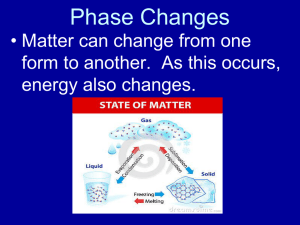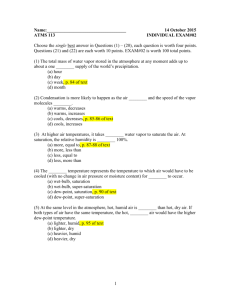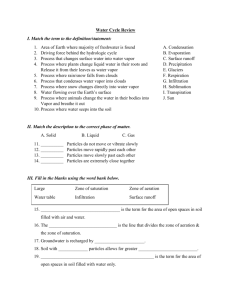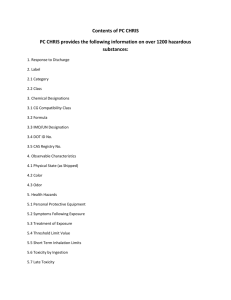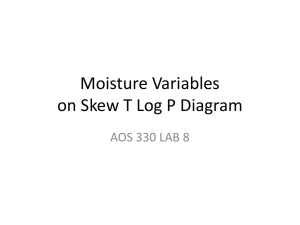Narrative Change of Phase
advertisement
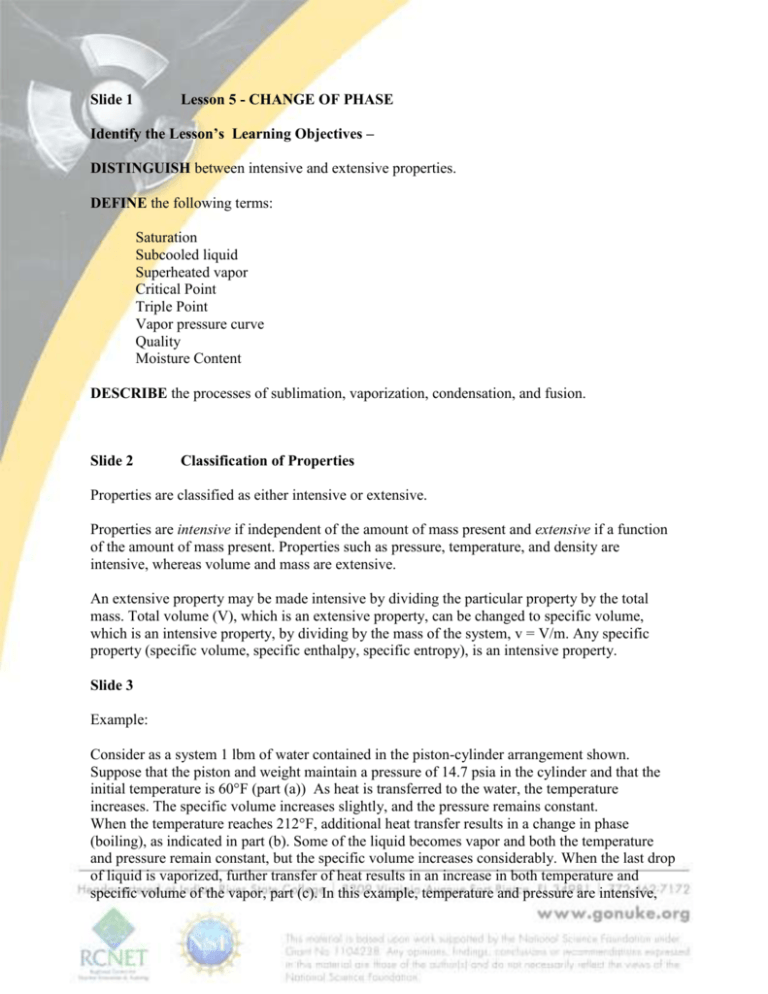
Slide 1 Lesson 5 - CHANGE OF PHASE Identify the Lesson’s Learning Objectives – DISTINGUISH between intensive and extensive properties. DEFINE the following terms: Saturation Subcooled liquid Superheated vapor Critical Point Triple Point Vapor pressure curve Quality Moisture Content DESCRIBE the processes of sublimation, vaporization, condensation, and fusion. Slide 2 Classification of Properties Properties are classified as either intensive or extensive. Properties are intensive if independent of the amount of mass present and extensive if a function of the amount of mass present. Properties such as pressure, temperature, and density are intensive, whereas volume and mass are extensive. An extensive property may be made intensive by dividing the particular property by the total mass. Total volume (V), which is an extensive property, can be changed to specific volume, which is an intensive property, by dividing by the mass of the system, v = V/m. Any specific property (specific volume, specific enthalpy, specific entropy), is an intensive property. Slide 3 Example: Consider as a system 1 lbm of water contained in the piston-cylinder arrangement shown. Suppose that the piston and weight maintain a pressure of 14.7 psia in the cylinder and that the initial temperature is 60°F (part (a)) As heat is transferred to the water, the temperature increases. The specific volume increases slightly, and the pressure remains constant. When the temperature reaches 212°F, additional heat transfer results in a change in phase (boiling), as indicated in part (b). Some of the liquid becomes vapor and both the temperature and pressure remain constant, but the specific volume increases considerably. When the last drop of liquid is vaporized, further transfer of heat results in an increase in both temperature and specific volume of the vapor, part (c). In this example, temperature and pressure are intensive, and therefore do not depend upon the amount of mass present. By examining the specific volume (an intensive property) of the water in the piston instead of the volume (an extensive property), we can examine how any portion of the water in the piston changes. Volume by itself tells us nothing about the water in the piston. However, by knowing the specific volume we can tell if the water is a liquid or steam. Slide 4 Classification of Properties (cont.) Saturation - A condition in which a mixture of vapor and liquid can exist together at a given temperature and pressure. Saturation Temperature (Boiling Point) - The temperature at which vaporization (boiling) starts to occur for a given pressure. Saturation Pressure – The pressure at which vaporization (boiling) starts to occur for a given temperature Subcooled Liquid – Liquid with temperature that is lower than the saturation temperature for the existing pressure. Quality (x) - The ratio of the mass of the vapor to the total mass of both vapor and liquid when a substance exists as part liquid and part vapor at saturation conditions Slide 5 Vapor Pressure Curve The term saturation defines a condition in which a mixture of vapor and liquid can exist together at a given temperature and pressure. The temperature at which vaporization (boiling) starts to occur for a given pressure is called the saturation temperature or boiling point. The pressure at which vaporization (boiling) starts to occur for a given temperature is called the saturation pressure. For water at 212°F, the saturation pressure is 14.7 psia and, for water at 14.7 psia, the saturation temperature is 212°F. For a pure substance there is a definite relationship between saturation pressure and saturation temperature. The higher the pressure, the higher the saturation temperature. The graphical representation of this relationship between temperature and pressure at saturated conditions is called the vapor pressure curve. A typical vapor pressure curve is shown here. The vapor/liquid mixture is at saturation when the conditions of pressure and temperature fall on the curve. Slide 6 T-V Diagram Showing the Saturation Region Saturated and Subcooled Liquids If a substance exists as a liquid at the saturation temperature and pressure, it is called a saturated liquid. If the temperature of the liquid is lower than the saturation temperature for the existing pressure, it is called either a subcooled liquid (implying that the temperature is lower than the saturation temperature for the given pressure) or a compressed liquid (implying that the pressure is greater than the saturation pressure for the given temperature). Both terms have the same meaning, so either term may be used. Quality When a substance exists as part liquid and part vapor at saturation conditions, its quality (x) is defined as the ratio of the mass of the vapor to the total mass of both vapor and liquid. X = mvapor / (mliquid + mvapor) Thus, if the mass of vapor is 0.2 lbm and the mass of the liquid is 0.8 lbm, the quality is 0.2 or 20%. Quality is an intensive property. Quality has meaning when the substance is in a saturated state only, at saturation pressure and temperature. The area under the bell-shaped curve on the figure shows the region in which quality is important. Moisture Content The moisture content of a substance is the opposite of its quality. Moisture (M) is defined as the ratio of the mass of the liquid to the total mass of both liquid and vapor. M = mliquid / (mliquid + mvapor) M = 1-X The moisture of the mixture in the previous paragraph would be 0.8 or 80%. The following equations show how to calculate the moisture of a mixture and the relationship between quality and moisture. Saturated and Superheated Vapors If a substance exists entirely as vapor at saturation temperature, it is called saturated vapor. Sometimes the term dry saturated vapor is used to emphasize that the quality is 100%. When the vapor is at a temperature greater than the saturation temperature, it is said to exist as superheated vapor. The pressure and temperature of superheated vapor are independent properties, since the temperature may increase while the pressure remains constant. Actually, the substances we call gases are highly superheated vapors. Slide 7 Slide 8 Classification of Properties (cont.) Moisture Content Saturated and Superheated Vapors Constant Pressure Heat Addition Constant Pressure Heat Addition T-V Diagram (temperature-volume) diagram shows the constant-pressure line that represents the states through which the water of the previous discussion passes as it is heated from the initial state of 14.7 psia and 60°F. Let state A represent the initial state and state B represent the start of the saturated liquid line (212°F). Therefore, line AB represents the process in which the liquid is heated from the initial temperature to the saturation temperature. Point C is the saturated vapor state, and line BC is the constant-temperature process in which the change of phase from liquid to vapor occurs. Line CD represents the process in which the steam is super-heated at constant pressure. Temperature and volume both increase during the process. Now let the process take place at a constant pressure of 100 psia, beginning from an initial temperature of 60°F. Point E represents the initial state, the specific volume being slightly less than 14.7 psia and 60°F. Vaporization now begins at point F, where the temperature is 327.8°F. Point G is the saturated-vapor state, and line GH is the constant-pressure process in which the steam is superheated. In a similar manner, a constant pressure of 1000 psia is represented by line IJKL, the saturation temperature being 544.6°F. Slide 9 Classification of Properties (cont.) Critical Point – Point where there is no constant-temperature vaporization process. Rather, point N is a point of inflection, with the slope being zero. Saturated-liquid and saturated-vaporstates are identical Fusion - The process of melting Sublimation - Transition between the solid phase and the vapor phase occurs directly, without passing through the liquid phase (dry ice). Triple Point - The state in which all three phases may be present in equilibrium Slide 10 Pressure – Temperature Diagram Critical Point At a pressure of 3206.2 psia, represented by line MNO, there is no constant-temperature vaporization process. Rather, point N is a point of inflection, with the slope being zero. This point is called the critical point, and at the critical point the saturated-liquid and saturated-vapor states are identical. The temperature, pressure, and specific volume at the critical point are called the critical temperature, critical pressure, and critical volume. A constant pressure process greater than the critical pressure is represented by line PQ. There is no definite change in phase from liquid to vapor and no definite point at which there is a change from the liquid phase to the vapor phase. For pressures greater than the critical pressure, the substance is usually called a liquid when the temperature is less than the critical temperature (705.47°F) and a vapor or gas when the temperature is greater than the critical temperature. In the figure, line NJFB represents the saturated liquid line, and the line NKGC represents the saturated vapor line. Fusion Consider one further experiment with the piston-cylinder arrangement of Figure 4. Suppose the cylinder contained 1 lbm of ice at 0°F, 14.7 psia. When heat is transferred to the ice, the pressure remains constant, the specific volume increases slightly, and the temperature increases until it reaches 32°F, at which point the ice melts while the temperature remains constant. In this state the ice is called a saturated solid. For most substances, the specific volume increases during this melting process, but for water the specific volume of the liquid is less than the specific volume of the solid. This causes ice to float on water. When all the ice is melted, any further heat transfer causes an increase in temperature of the liquid. The process of melting is also referred to as fusion. The heat added to melt ice into a liquid is called the latent heat of fusion. Sublimation If the initial pressure of the ice at 0°F is 0.0505 psia, heat transfer to the ice first results in an increase in temperature to 20°F. At this point, however, the ice passes directly from the solid phase to the vapor phase in the process known as sublimation. Sublimation is a special term used for cases in which the transition between the solid phase and the vapor phase occurs directly, without passing through the liquid phase. Further heat transfer would result in superheating the vapor. Triple Point Finally, consider an initial pressure of the ice of 0.08854 psia. Again, as a result of heat transfer, the temperature will increase until it reaches 32°F. At this point, however, further heat transfer may result in some of the ice becoming vapor and some becoming liquid because it is possible to have the three phases in equilibrium. This is called the triple point, defined as the state in which all three phases may be present in equilibrium. Figure 8 is a pressure-temperature diagram for water that shows how the solid, liquid, and vapor phases may exist together in equilibrium. Along the sublimation line, the solid and vapor phases are in equilibrium, along the fusion line, the solid and liquid phases are in equilibrium; and along the vaporization line, the liquid and vapor phases are in equilibrium. The only point at which all three phases may exist in equilibrium is the triple point. The temperature and pressure for the triple point of water are 32.02°F and 0.08865 psia. The vaporization line ends at the critical point because there is no distinct change from the liquid phase to the vapor phase above the critical point. Condensation All the processes discussed on the preceding pages (vaporization, sublimation, and fusion) occur during a heat addition to a substance. If heat is removed from a substance, the opposite of the described processes will occur. As previously described, a heat addition at a constant pressure to a saturated liquid will cause the liquid to evaporate (change phase from liquid to vapor). If heat is removed at a constant pressure from a saturated vapor, condensation will occur and the vapor will change phase to liquid. So the processes of vaporization and condensation are the exact opposite of each other. Similarly, freezing is the opposite process of melting and fusion. Sublimation also has an opposite process in which a gas goes directly to solid, but this process is not normally referred to with a unique term. Slide 11 Change of Phase Summary Classification of Properties Intensive properties are independent of mass (temperature, pressure, or any specific property) Extensive properties are a function of the mass of the system (mass, volume) Slide 12 The following terms were defined in this chapter: Saturation - combination of temperature and pressure at which a mixture of vapor and liquid can exist at equilibrium Subcooled liquid - a liquid at a temperature below saturation temperature for its pressure Superheated vapor - a vapor at a temperature above saturation temperature for its pressure Critical point - the temperature and pressure above which there is no distinction between the liquid and vapor phases Triple point - the temperature and pressure at which all three phases can exist in equilibrium Vapor pressure curve - a graphical representation of the relationship between temperature and pressure at saturated conditions Quality - the fraction of the total mass of a mixture that is in the vapor phase Moisture Content - the fraction of the total mass of a mixture that is in the liquid phase Slide 13 The following terms are labels for processes that occur when a substance changes between the three phases of matter: solid, liquid, and vapor. Sublimation - change of phase from solid to vapor Vaporization - change of phase from liquid to vapor Condensation - change of phase from vapor to liquid Fusion or melting - change of phase from solid to liquid



